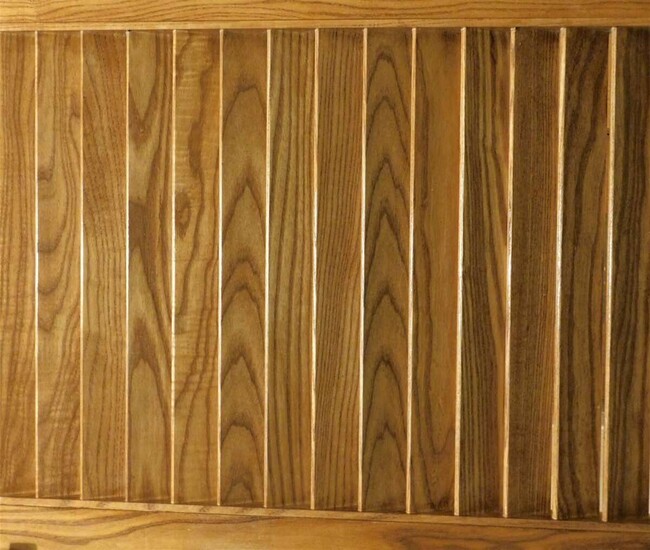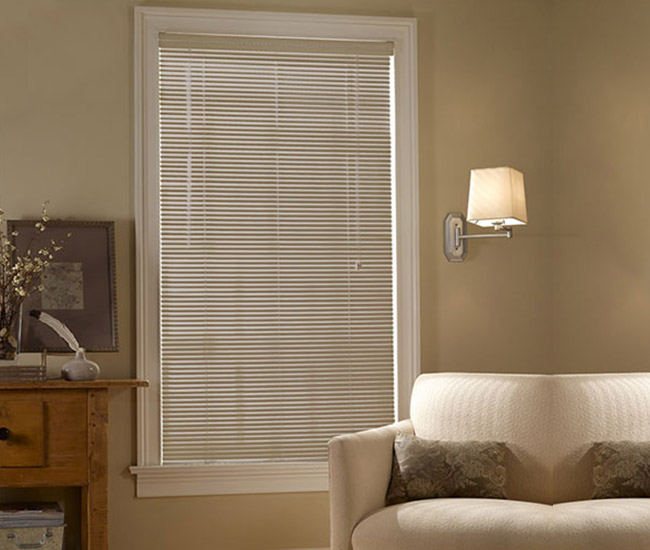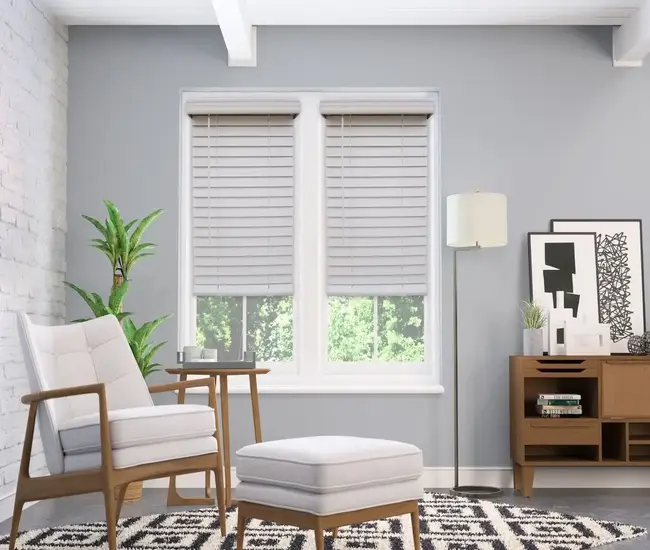If you’re shopping for window blinds, you’ll have many different types of materials, types, and styles to choose from. Lightweight and durable materials such as synthetics and vinyl will work best on large windows. Light filtering fabrics will offer glare-free light and privacy in your dining room. Blackout fabrics are the best option for bedrooms. Blackout mini aluminum blinds will add decorative touch and 100% light control to your kid’s bedroom. Faux wood is a great, water-resistant material for your kitchen, bathrooms, and other high moisture areas.
As each kind of window blind material has its pros and cons, it can be tough to know which material is best for your home. To help you with your choice, here is a comprehensive guide to the benefits of each type of window blind material.
Fabric, wood, faux wood, aluminum, and vinyl are the most popular material choices when buying new window treatments.
Scroll on to discover the benefits of each type of window blinds material.
Key Points
- There are many different types of window blinds materials, types, and styles on the market, each with its own benefits.
- The best material for your home’s window blinds depends on your specific needs and preferences.
- When choosing a suitable material for your window coverings, it’s important to consider factors like durability, ease of cleaning, and light filtration.
What are the Pros and Cons of Each Type of Window Blinds Material?
Window blinds are available in a great diversity of materials, each with its own unique advantages and disadvantages. The window blinds materials that are popular among homeowners include wood, faux wood, fabric, aluminum, vinyl, and PVC.
Below are the benefits of different types of window blinds materials.
Fabric Blinds – a Versatile Choice for Beautiful Interiors

Pros
- Fabric blinds are a soft and cool option for windows.
- Fabrics come in lots of colors, patterns, and textures.
- Fabrics window blinds can be custom sized to fit your window.
- These materials are great for providing privacy and blocking out light.
Cons
- Fabric window blinds are more difficult to clean than other window treatments.
- Fabrics are prone to sun damage.
Pros and Cons of Wood – A Durable but Expensive Option

Pros
- Wood blinds are elegant and classic.
- They can be stained or painted to match any décor.
- Wood blinds, such as woven wood shades, offer a warm and natural look that complements a variety of interior decor styles.
- Wood is a good natural insulator. Wood blinds can help to keep your room cooler in the summer and warmer in the winter.
- Wood blinds are a long-lasting window covering option for your home or office.
- Wood blinds for windows allow you to easily control the amount of light that enters your room.
- Wooden window blinds offer a high level of privacy.
Cons
- Wood blinds can be expensive window treatments.
- They require regular maintenance to keep them looking their best.
Aluminum – Lightweight, Durable but Noisy

Pros
- Aluminum blinds are very durable.
- Aluminum window blinds are easy to care for.
- They are a great choice for high-traffic areas.
Cons
- Window blinds made from aluminum can be noisy.
- They may not provide as much insulation as other materials.
Benefits and Drawbacks of PVC as a Window Blinds Material
Pros
- PVC blinds are very affordable.
- PVC is easy to clean.
- It is an ideal choice for busy households.
Cons
- PVC material for window blinds is not as durable as some other materials.
- It may warp or crack over time.
Benefits of Faux Wood

Pros
- Faux wood blinds are a cost-effective alternative to real wood.
- They are designed to look like real wood.
- They are durable and easy to clean window blinds.
Cons
- Faux wood blinds may sometimes appear artificial or plastic-like up close.
- Faux wood is not as strong as real wood.
- Faux wood blinds are often heavier than real wood window blinds, which can make them more difficult to install or operate.
Benefits of Vinyl
Pros
- Vinyl blinds are a cost-effective option for your windows.
- They are lightweight, durable, and easy to clean window blinds.
- Vinyl is available in a variety of colors and styles.
Cons
- Vinyl blinds have a plastic-like appearance, so they are not as attractive as wood or fabric blinds.
- Vinyl is not as strong as wood or aluminum.
Now that you know about the pros and cons of different types of window blinds materials, it’s time to find the best option for your home. Read on to learn more about how to choose the right window blind material for your needs!
Factors to Consider When Choosing a Window Blinds Material

How to choose the right window blind material for your needs? When it comes to choosing the right window blind material for your home, there are a few factors you’ll want to consider.
While window blinds are a popular choice for window treatments, there are a few things to keep in mind when choosing the right window blinds material for your needs. The most popular materials for window blinds are wood, metal, and synthetics. Each has its own benefits and drawbacks.
For example, wood is a natural material that is easy to clean and maintain. However, it can be susceptible to damage from sunlight and moisture. Metal is a durable option that is available in a variety of colors and styles. However, it can be noisy if not installed properly.
Synthetic materials, such as PVC or polyester, are often more affordable than other options. They are also available in a wide range of colors and styles. However, they may not be as durable as other materials.
Intended Use of Window Blinds
Think about how the blinds will be used. If you have young children or pets, you’ll want to choose a durable material that can stand up to wear and tear. If you’re looking for window blinds that will filter out light, look for materials like blackout fabric or wood blinds.
Affordability
Affordability is an important factor to consider when choosing a material for window blinds. For example, if you are low on budget, you should go for faux wood blinds. On the other hand, if you can pay more, choose wood blinds.
The Best Window Blind Material for Your Home
The best type of window blind for your home will depend on your specific needs and preferences.
If you’re looking for window blinds that offer maximum privacy and a room darkening effect, you might want to consider blackout roller shades.
If you’re more concerned with energy efficiency, choose window blinds made from a light-blocking material.
And if you want window blinds that are easy to clean, look for window blinds made from a durable and easy-to-clean material.
Whatever your needs, there’s a window blind material that’s right for you.
Bottom Line
When it comes to window blinds, there are a variety of materials to choose from. Each material has its own advantages and disadvantages, so it’s important to select the option that best suits your taste and needs. Wood is a popular rustic choice for window blinds because it is durable, provides good insulation, and brings nature closer to your living space.
However, wood is also susceptible to warping and discoloration over time. Metal window blinds are also very durable, but they can be noisy when opening and closing. PVC is another option for window blinds.
It is relatively inexpensive and easy to clean, but it can yellow or fade over time. Ultimately, the best choice for window blinds depends on your individual needs and preferences.
FAQs
What are the best styles of window blinds?
The best styles of window blinds include roller blinds, Roman blinds, Venetian blinds, and mini blinds.
- Roman fabric blinds are a luxurious choice for beautifully decorated interiors.
- Tightly woven roller blinds are a great choice for rooms that receive a lot of sunlight, as they can be easily rolled down to block out all light.
- Honeycomb fabric cellular shades are best suited for insulating windows of bedrooms, offices, and dining rooms.
- Mini aluminum blinds are best suited for bedrooms, as they slats can be tightly closed to block out all light.
- Panel blinds, available in a variety of textures, patterns, and colors, are a great choice for sliding glass doors and large windows in dining rooms or living rooms.
- Venetian blinds are best suited for any windows.
How do I choose fabric blinds?
- If you want to reduce glare and absorb more heat, choose darker fabrics.
- Lighter fabrics are an excellent choice for reflecting more light.
- Tighter or closed fabric weave is the best choice for more privacy in a room.
- Beautifully patterned fabric blinds will add a pop of color to your windows.
What kind of material would make a good window blind?
Fabric, such as polyester, PVC, or acrylic is the most versatile material for indoor blinds to add beauty and provide varying degrees of insulation and light control.
Wood is a popular and durable material for venetian blinds and plantation shutters to add a ‘wow’ factor to living rooms, bedrooms, and studies.
Faux wood blinds, an affordable alternative to wooden blinds, add warmth and style to any space.
What are the most durable types of blinds?
Wood blinds, faux wood blinds and shutters are the most durable type of blinds, as they can resist heat damage and fading, and can hold up well in humid areas, like bathrooms, kitchens, laundry rooms, and basements. They last for years, require little maintenance, and provide a gorgeous, sleek appearance to your interior.
Still Unsure?
Need to know more about the best fabric blinds and other types of window coverings? Contact our professionals using 24/7 live chat or give us a ring at (800) 863-6109 for expert advice and a custom solution.
